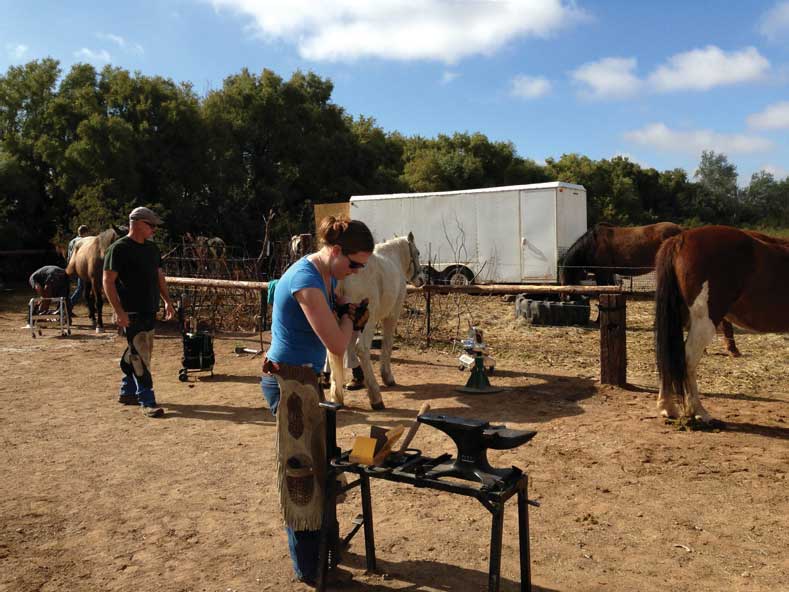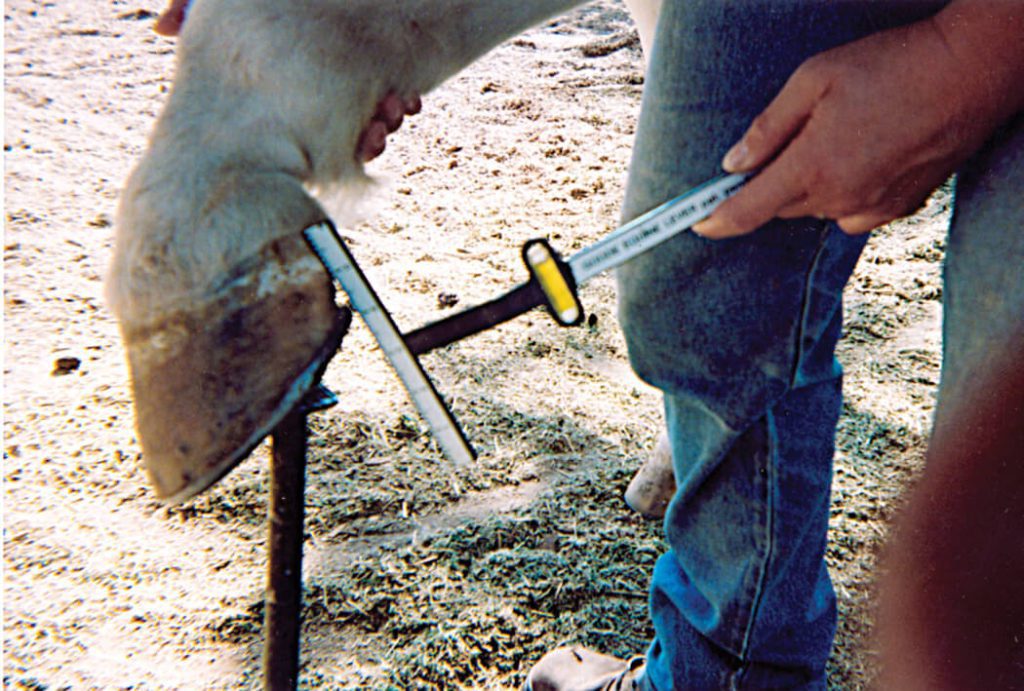What it takes to become a shoer
Physical Condition
Most of our students are in fairly good shape, considering that they have not done any horseshoeing before. We don’t know of any exercise you can do to prepare yourself for shoeing. Most students’ legs and backs get sore for about a week, but then there are no more problems.
Attitude
First of all, you need a fondness for horses. You must also like to work with your hands and to be outdoors. All of your work will most likely be outdoors.
Patience and even temperament are essential in handling horses. You need patience when a horse is not cooperating with you. You need the patience to find out what is wrong with the horse.
Even temperament means not striking the horse with your hammer or rasp when he will not let you shoe him, but keeping a cool head and using some sort of restraint like a twitch, war bridle, or sideline. Remember, 95% of horses are good to shoe, 5% are bad. Much more can be accomplished with gentle persuasion and kindness towards the animal than with abusive treatment.

Our Curriculum
Anatomy of the Legs and Feet
You will learn to recognize the name of the parts of the lower leg and foot. The way the leg is formed affects the way that the horse stands and moves. Since 50% of a horse’s problems occur from the knee down, they fall directly within the realm of the horseshoer’s influence. The anatomy and physiology of horses’ legs and feet are basic.
Physiology of the Legs and Feet
You will learn how the different parts of the leg and hoof work. You will also understand how changes in normal structure can cause faulty gait, injury, and even disease. Our primary objective is to teach you to shoe “normal” and “problem” horses. This includes learning to recognize and correct traveling and lameness problems where they occur.
Equine Conformation
You are taught about the way skeleton and muscles are put together and how that varies from breed to breed. You will be able to recognize what constitutes good conformation for the different breeds and why. You will also learn how horses are judged for conformation. With this knowledge you will be able to shoe to correct for faults and improve conformation.

Starting your Business
You will learn how to set up your business and conduct your relationships with your clients, veterinarians, and competitors. You will also learn why you should work closely with each of these groups.
Basic Blacksmithing
Our course begins in the classroom and moves to the forge. Each student learns the proper use of the blacksmith forge. You will learn how to build fires to get the proper heat from your forge in accordance with the type of job you are doing. At the forge, you will learn the use of different types of metal. We also teach forge welding and the brazing of calks and garbs. You will learn the proper use of the anvil. You will also have access to arc and acetylene welders, saws, grinders, and other facilities in the shop. These skills will enable you to do corrective shoeing.
Trimming the Foot
As soon as the class learns to make horseshoes from steel bar stock, we start instruction on trimming and corrective trimming. We cover the hand tools, name, purpose, proper use, and care of each tool.
Leveling and Balancing the Foot
Much more science is involved in the proper trimming of the foot than in the fitting and nailing of the shoe. To level and balance the foot, the shoer must first be able to determine when the foot is level. This is not an easy job and in cases of deformed feet, is a decidedly difficult task.
THREE ESSENTIAL TOOLS TO BALANCE YOUR HORSES’ FEET
HOOF GAUGE → ANGLES
DIVIDER → TOE LENGTH
EQUINE T SQUARE → SIDE TO SIDE

Normal Shoeing
Having mastered trimming, you will learn to put shoes on the horses. This will not be any great feat after you learn to level the foot and make shoes that fit properly. You will learn how to choose the right size and length of bar stock to properly fit normal hooves and nail and finish your work using the right methods and tools.
Corrective Shoeing
You will learn to balance horses for soundness and performance. Some lameness can be corrected by shoeing. You will learn how to recognize them and how to determine which corrective shoe to use. You will learn about lameness caused by improper shoeing and how to change a horse’s mode of travel to stop forging, interfering, scalping, cross-firing, knee hitting, speed cutting, etc. As the course progresses you will be making hand tools, swedge blacks, race plates, harness horseshoes, gaited horseshoes, and a variety of corrective shoes with calks, trailers, toe grabs, rolled toes, bars, etc. The course will concentrate on the pleasure horse because today they are by far the predominant horse.
Horse Handling
You will have many opportunities to learn the finer points of horse handling, particularly when working with colts and horses being trimmed or shod for the first time. Many of our longtime customers permit the Native American Horse Education Foundation to work on their horses under my supervision. So students have plenty of horses to work on. Besides a large number of horses near the school, we supply student shoers for several riding stables and a riding school. One stable alone provides the school with over two hundred head of horses.
Equine Nutrition
You will learn a basic healthy diet for horses, how to feed horses according to the way they are used, and dealing with those problems.
MEETING COMMUNITY NEEDS
There are many livestock owners on Native American reservations, and all of them need to take care of their horses’ feet. By learning horseshoeing skills. livestock owners will become more self-sufficient with their horse-care, save money, have the potential to earn more money, and most importantly, improve the quality of horses on the Nation.
SUPPORTING NATIVE AMERICAN NATIONS MISSION
Horseshoeing is a universal skill that cuts across all cultures and nations. If people own horses, they need to care for their horses’ feet. Practical skills such as horseshoeing add an important component to your course offerings.
Families often share responsibilities when it comes to taking care of their horses. If one member of a family has horseshoeing skills, they are more likely to teach other family and community members those skills, so that people will increasingly have access to better horse and hoof care. Properly taking care of horses is also a life skill that can increase a person’s sense of self-worth and self-sufficiency.
MEETING NATIVE AMERICAN NATIONS GOALS
Horseshoeing can be an endeavor that provides personal satisfaction by providing for animals. It can also be turned into a competitive business to support a person and their family. Horseshoeing, while an ancient craft, is also ever-changing with new technologies and needs.
Horseshoeing has been done by Native American Tribes for hundreds of years and is part of their culture, respect for life and caring for animals. Horses will always be a part of the American landscape and it will always be a challenge to properly care for the number of horses. Having trained individuals to care for these horses will always be of service to the nation in the future.



